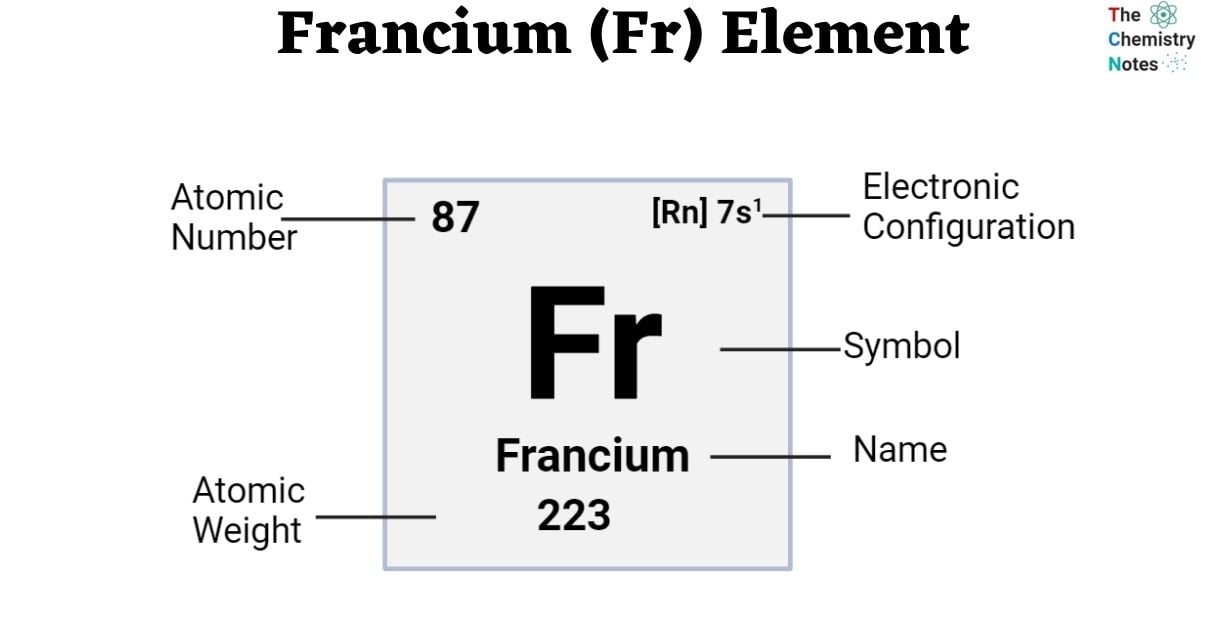Francium is a chemical element with the atomic number 87 and it is represented by the symbol ‘Fr’ in the periodic table. It belongs to Group 1 and Period 7 of the periodic chart. It is classified as an alkali metal. It is a soft, low-melting, silvery-white metal. In terms of electro-positivity, it ranks second only to cesium (Cs) and is the second-rarest naturally occurring element (after astatine). The earth’s crust contains no more than 15 grams of this element.

Francium is formed through the disintegration of alpha particles contained in uranium crystals. Fr is created by bombarding radium with neutrons in a nuclear reactor. It is also possible to create it by blasting thorium with protons.
Interesting Science Videos
History of Francium
- The Russian scientist Dmitri Mendeleev, who initially devised the periodic table, had hypothesized the presence of a yet-to-be-discovered element that was comparable to cesium.
- In 1935, Marguerite Perey, then 26 years old, saw a study report saying that American scientists had identified beta particles being released by actinium, which had a larger quantity of energy than usual.
- Marguerite Perey made her find of francium in 1939 while analyzing the radioactive disintegration of actinium-227.
- The last naturally occurring element discovered by humans was francium rest of all were synthesized in the lab.
- The name of the chemical is derived from France, where it was discovered.
Occurrence of Francium
- Francium arises naturally as a byproduct of actinium’s alpha radioactive decay, which happens 99% of the time.
- There are very few francium isotopes found in uranium minerals. It is found naturally in uranium and thorium ores, however, this is due to decay rather than compound formation.
- Francium’s terrestrial abundance is predicted to be around 2 x 10 -18 ppm.
- Francium is so radioactive that its most stable isotope (Francium-233, formerly known as actinium-K) has a half-life of only 22 minutes.
- Francium is synthesized by a fusion process with gold-117 that is bombarded with oxygen-18 molecules. The energy of the oxygen beam induces the production of several distinct isotopes of francium.
- Francium has 33 isotopes with recorded half-lives, ranging in mass from 200Fr to 232Fr. None of them are stable.
Elemental Properties of Francium
| Electronic Configuration | [Rn] 7s1 |
| Atomic Number | 87 |
| Atomic Weight | (223) g.mol -1 , no stable isotope |
| State at 20°C | Solid |
| Group, Period, and Block | 1, 7, s-block |
| Density | 1.873 g.cm-3 at 20 °C |
| Appearance | greyish-silvery (estimated) |
| Van der Waals radius | unknown |
| Electron shells | 2, 8, 18, 32, 18, 8, 1 |
| Electrons | 87 |
| Protons | 87 |
| Neutrons in the most abundant isotope | 136 |
Physical Properties of Francium
- There isn’t much information available on Francium’s texture, appearance, or shape. It is projected that francium would emerge as a solid metal, with a body-centered cubic crystalline structure.
- The valence shell electronic arrangement implies that the chemical and physical characteristics of francium are comparable to those of the alkali metal cesium.
- Francium has an atomic number of 87 and is an alkali metal. It has a melting point of 27 °C, (81 °F) and a boiling point of 677 °C (1251 °F).
- Fr has a solid phase density of 1.873 g/cm3 (estimated) at near room temperature.

Chemical Properties of Francium
- Francium is a metal that is alkaline.
- Its chemical characteristics are similar to those of cerium.
- It has the highest equivalent weight of any element.
- The electronegativity of francium is identical to that of cesium. Francium can create compounds with other elements using various techniques, but these are again highly transient and have few, if any, useful applications.
Chemical Reaction of Francium
All of the reactions given below are hypothetical.
- The Reaction of Francium with Air
An entirely fresh francium surface would quickly tarnish due to an interaction with oxygen and moisture in the air. If francium were to be burnt in the air, the outcome would be francium superoxide, FrO2.
Fr (s) + O2 (g) → FrO2 (s)- The Reaction of Francium with Water
It’s unlikely that anybody has ever documented how francium reacts with water. Given that all of the other Group 1 elements react to form a colorless combination of hydroxide and hydrogen gas (H2), it’s odd that francium doesn’t do the same. The reaction would likely occur more quickly than with cesium, making it potentially hazardous.
2Fr (s) + 2H2O (l) → 2FrOH (aq) + H2- The Reaction of Francium with Halogens
We may expect that francium metal will react strongly with all halogens to produce francium halides.
Francium might react with chlorine, Cl2, to form francium (I) chloride, FrCl.
2Fr (s) + Cl2 (g) → FrCl (s)Francium might react with fluorine, F2, to form francium (I) fluoride, FrF.
2Fr (s) + F2 (g) → FrF (s)Francium might react with bromine, Br2, to form francium (I) bromide, FrBr.
2Fr (s) + Br2 (g) → FrBr (s)Francium might react with iodine, I2, to form francium (I) iodide, FrI.
2Fr (s) + I2 (g) → FrI (s)Uses of Francium
Francium has no commercial application due to its scarcity and a state of instability It is used solely for research purposes.
- It has been used to discover the coupling constants between subatomic particles and energy levels in spectroscopic research.
- It’s possible that the element will be used in cancer diagnosis testing.
Health Hazards of Francium
- Since it is so unstable, any amount generated would decay to other elements so fast that studying its impact on human health is pointless.
Environmental Impacts of Francium
- There is no cause to examine the environmental implications of francium due to its relatively short half-life.
Video Reference
References
- https://www.webelements.com/francium/chemistry.html
- https://www.chemistrylearner.com/francium.html
- https://www.priyamstudycentre.com/2022/07/francium.html
- https://www.americanelements.com/francium.html
- https://chemicalengineeringworld.com/francium-element-properties-and-information/
- https://www.chemicool.com/elements/francium.html
- https://chemistrydictionary.org/francium/
- https://www.rsc.org/periodic-table/element/87/francium

